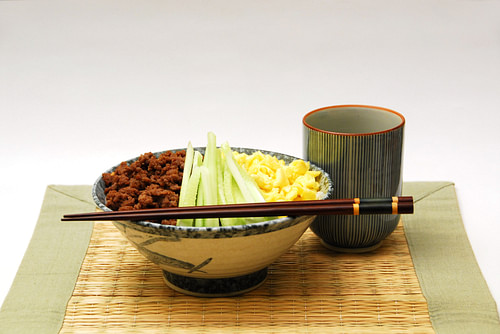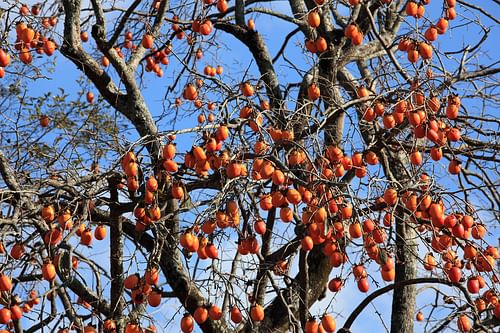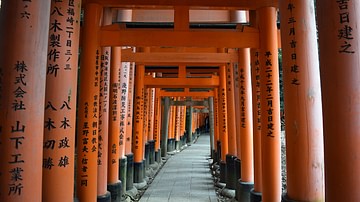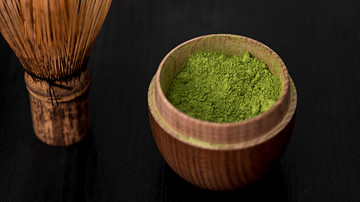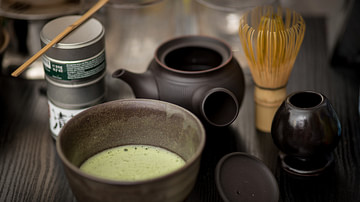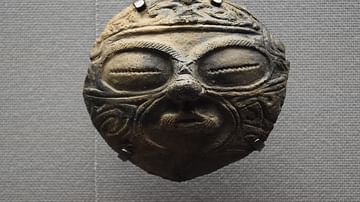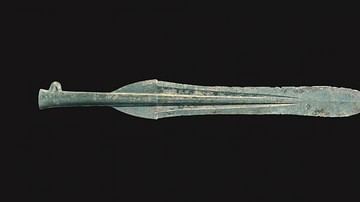The diet of ancient Japan was heavily influenced by its geography as an archipelago, foodstuffs and eating habits imported from mainland Asia, religious beliefs, and an appreciation for the aesthetic appearance of dishes, not just the taste. Millet was replaced by rice as the main staple food from c. 300 BCE and seafood was preferred to meat, both for its abundance and because Buddhism, introduced in the 6th century CE, largely prohibited the killing of animals and birds. A wide variety of fruit and vegetables were available while tea and sake were the popular drinks, at least for the aristocracy.
Geography & Weather
The geography of Japan is varied and so, therefore, is each region's capacity for agriculture. The Inland Sea basin between Honshu and Shikoku benefits from heavy rains during the growing season and sunny, dry days of subtropical temperatures prior to harvest, while late Autumn rains coming in with the Pacific Ocean winds and mild winters help winter crops. Delayed rains or early typhoons can destroy crops. In contrast, the north-west of Honshu receives icy winds and snow sweeping in from Asia.
Mythology
Given the fickle whims of Nature and the real possibility of devastating weather phenomena which could wipe out crops, it is not surprising that the ancient Japanese conjured up deities to protect their interests.
Food (shokumotsu) could have its own gods. There was a general and ancient food goddess from Ise, and Inari was established as the national rice god long after local rice gods had already been protecting farmers and promising them a good harvest when they received suitable offerings. Even rice fields had their own protective Shinto spirit, ta no kami. An important part of agriculture were religious ceremonies and rituals, especially around sowing and harvest time, which were meant to ensure a good crop and protect it from disasters. Ceremonies involving rice were particularly important and involved the emperor. Famine, too, was represented in mythology as an old crone who had set fish traps to deprive the people of salmon but who was eventually killed by the hero Okikurmi. Buddhism also featured food-related figures, notably Iorin, a manifestation of Kannon, who is the patroness of fishermen, and Ida-ten, the god of the meal in Zen sects. The latter is prayed to before meals and watches for any excess of appetite.
Agriculture
Agriculture (nogaku) in ancient Japan, as it remains today, was largely focussed on cereal and vegetable production, with meat only being produced in relatively limited quantities. Early food sources during the Jomon Period (c. 14,500 - c. 300 BCE or earlier) were millet and edible grasses. The first traces of crop cultivation date to c. 5700 BCE with slash-and-burn agriculture. Farming of specific and repeated areas of land occurred from c. 4,000 BCE.
By far the most important staple food was rice. There is evidence of rice c. 1250 BCE, introduced to Japan via migrants from mainland Asia in the late Jomon Period, but its cultivation was likely not until c. 800 BCE. The first evidence of growing rice in wet fields dates to c. 600 BCE when the technique was introduced, again by migrants from Asia, during the transition from the Jomon to the Yayoi Period. The earliest paddy fields appeared in the south-west and then spread northwards. Yayoi immigrants also brought azuki beans, soybeans, wheat, and, from China, what has become the Japanese dish par excellence, sushi.

Agricultural was slow to develop, and it was not until the introduction of iron tools and techniques from Korea in the Kofun Period (c. 250 - 538 CE) that progress was made in efficiency. Even during the Nara Period (710-794 CE) agriculture still depended on primitive tools, not enough land was prepared for crops, and irrigation techniques were insufficient to prevent frequent crop failures and outbreaks of famine (notably in 730 CE and c. 1180 CE). There was some state support in the form of loans of seed-rice in the 9th century CE, but the interest rates were between 30 and 50%. Only the Kamakura Period (1183-1333 CE) and medieval times would see such techniques as double-cropping, better seed strains and a wider use of fertiliser.
Given this unreliability, most small farmers preferred the greater security of working for landed aristocrats on their large estates (shoen). Only these estates were properly irrigated, and small independent farmers had to do with rainfall or natural underground sources, and so settle for dry field crops like millet (and hemp) as well as barley, wheat, and buckwheat. Rice, when grown in such conditions, was reserved to pay taxes. Other crops included barley and mulberry, the latter needed for the production of silk.
Diet
As Japan is a collection of variously sized islands, seafood was easily acquired and was much more popular than meat, animal husbandry being a more costly and time-consuming source of food. Examples of seafood eaten are shellfish, seaweed, sea cucumber, bonito, bream, sea bass, eel, carp, mackerel, sardine, salmon, trout, shark, prawns, squid, jellyfish, and crab. Fish, if not eaten fresh and on site, was transported inland dried.
When Buddhism was introduced into Japan in the 6th century CE and then officially adopted and sponsored by the state, the religion, with its avoidance of killing animals and birds, provided another reason for seafood and vegetables to dominate the Japanese diet. Buddhism did not prohibit the eating of all types of meat, with wild boar and venison being exceptions to the rule. Pheasant was another meat which maintained its popularity. It is also true that some Buddhist sects were stricter and required their followers to eat a vegetarian diet.
They send cormorants forth
Over the upper shoals,
They cast dipper nets
Across the lower shoals.
Mountain and river
Draw together to serve her -
A god's reign indeed!
Manyoshu poem by Kakinomoto Hitomaro on Natures bounty for Empress Jito (Ebrey, 150).
The best-known period regarding Japanese diet is the Heian Period (794-1185 CE) when literature flourished and references to eating practices can be found amongst the court intrigues and romantic interludes. Our knowledge is largely restricted to that of the aristocracy as they were the ones who wrote the literature and they concentrated on their own lavish dinner parties held in their pleasure palaces of the capital Heiankyo (Kyoto). We can imagine that the diet of the ordinary population was much less palatable, although it might have been healthier as many a noble court writer alludes to the boils and other maladies related to malnutrition which plagued the imperial court.
Aristocrats had two meals a day - one at around 10 am and the second at 4 am but, again, we can imagine that labourers and farmers probably ate early and late in the day so as not to interfere with their work. People would have eaten snacks, too, of fruit, nuts, or rice cakes, for example.
Rice, the staple, was boiled, steamed, or cooked and then dried. It was mixed with vegetables to make rice cakes or made into a thick porridge and spiced up with vegetables or other cereals. Popular vegetables included the versatile soybean which could be made into a flavouring paste (miso), tofu (bean curd), or soy sauce. There were red beans, Japanese sweet potatoes, bamboo shoots, aubergines, cucumbers, burdock, onions, spring onions, yams, and radishes. They were eaten raw or boiled, steamed or pickled. Food was seasoned using salt, ginger, mint, garlic, vinegar, and fish broth. A sweeter taste was achieved by adding honey, a rice jelly, or a liquid known as amazura which was pressed from wild grapes. Another way to add extra taste was cooking using walnut or sesame oil.
Fruit available included peaches, the Japanese orange, tangerines, persimmons, loquats, plums, pomegranates, apples, raspberries, and strawberries. There were also nuts such as chestnuts, walnuts, and pine nuts. Fats were provided (probably in insufficient quantities) by eggs, milk and butter products.
Such quintessential Japanese dishes as tempura and sukiyaki were introduced to the islands much later - tempura via the Portuguese in the 16th century CE and sukiyaki in the early 20th century CE after beef was made fashionable there by western Europeans.

Tea (cha) was another popular introduction from China (6th-7th century CE), and according to tradition it first grew from a bush which grew from the discarded eyelids of the sage Daruma (aka Boddhidarma), the founder of Zen Buddhism. Also from China came better tea plants and the elaborate ceremony involved in its preparation (chanoyu). Tea drinking was first adopted by Zen Buddhist monks as it was thought to aid meditation and ward off sleep. The drink was also considered to have medicinal qualities. The tea was prepared by pounding the leaves and making a ball with amazura or ginger, which was then left to brew in hot water. Eventually, from 1200 CE, specialised tea schools were opened, people drank in dedicated tea rooms (chashitsu), and people's finest porcelain was reserved for tea drinking.
Finally, one important drink which, again, remains a quintessential symbol of Japan is sake or rice wine. In mythology, the drink comes from Tokyo, a gift from Sukunabikona, the god of magic and healing. Sake was and is a common offering to the gods of Shinto shrines. Finally, illustrating the antiquity of sake and its importance in Japanese culture, Otomo no Tabito (665-731) famously composed 13 poems praising the drink, and here is one of them:
Instead of fretting
Over things of no avail,
It would seem better
To drink a cupful
Of clouded sake.
(Keene, 137)
This content was made possible with generous support from the Great Britain Sasakawa Foundation.
